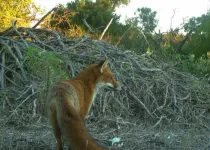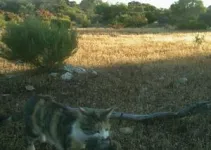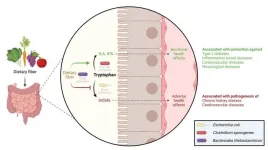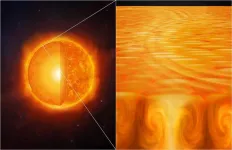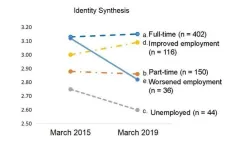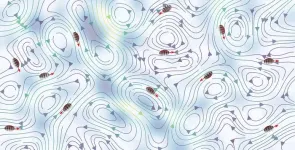(Press-News.org) Giant lizards called heath goannas could save Australian sheep farmers millions of dollars a year by keeping blowfly numbers down - and must be prioritised in conservation schemes to boost native wildlife, say researchers.
A study led by the University of Cambridge has found that heath goannas - a species of giant, scavenging lizard - act as natural clean-up crews by clearing maggot-ridden animal carcasses from the landscape.
This reduces the emergence of blowflies, which attack sheep by laying eggs on their backsides that hatch into flesh-eating maggots. The disease, known as ‘fly strike’, costs the Australian sheep farming industry an estimated $280 million a year.
This study was carried out at 18 sites across the Marna Banggara Rewilding Project area on Australia’s southern Yorke Peninsula, where over 90% of the native mammals are now extinct.
The study found that heath goannas perform a superior blowfly control service to introduced European mammals, including red foxes and cats, which are displacing them.
The researchers say that boosting populations of native large reptiles like heath goannas is vital in restoring Australia’s ecosystem and the services it supports.
“We found that Australia’s native scavengers like heath goannas are much more effective in removing blowflies from the landscape than invasive scavengers like European foxes and cats,” said Tom Jameson, a PhD researcher in the University of Cambridge’s Department of Zoology and first author of the report.
High densities of blow flies put sheep at risk of ‘fly strike’, a disease where blowfly maggots burrow into the sheep’s flesh and start to eat it alive, causing painful wounds. This affects the market value of the sheep, reduces breeding success and often results in death.
“Blowflies are a massive problem for the Australian sheep farming industry. They cause a horrible disease that is expensive for farmers to manage and a real animal welfare problem for sheep,” said Jameson.
This is the first study to show the importance of large reptiles as scavengers. It is published today in the journal Ecology and Evolution.
To get these results Jameson compared the scavenging activity of different animals in a region of southern Australia. He left hundreds of dead rats at feeding stations, with camera traps, across the landscape. He returned after five days to see whether the rats had been eaten, and to count the number of blowfly maggots left on any remaining carcasses. Camera trap footage revealed which scavenging animal had found the rat, and how quickly.
Native Australian scavengers ate more of the dead rats, and with them the flesh-eating maggots, than scavengers introduced from Europe.
“It was disgusting – we were counting maggots. After five days we’d find over 1000 maggots in one rat if a scavenger hadn’t found it. Those maggots produce blowflies that can spread up to 20 kilometres in a week, putting local sheep flocks at risk of fly strike,” said Jameson.
In natural situations, any dead animal in the landscape will fill with blowfly maggots very quickly.
“The results suggest that conservation work in southern Australia to remove invasive species should also focus on boosting the population of heath goannas and other native species because they’re really important for the wider ecosystem,” said Jameson.
He added: “As well as benefiting native wildlife this will have knock-on benefits for local agricultural industry, and also attract more wildlife tourism.”
Marna Banggara, supported by Narungga traditional owners, is an ambitious rewilding project that aims to restore ecosystem health in the region by reintroducing missing native Australian species.
Eighteenth century European settlers to Australia brought with them red foxes for hunting, and cats as pets. Australia’s native wildlife - including many scavengers - has since been decimated by them.
The heath goanna is an endangered species of giant lizard native to the heathlands of southern Australia that can grow up to a metre and a half in length. It feeds on the dead carcasses of other animals, as well as catching live animals.
Reptiles like the heath goanna are the largest remaining native land scavengers in much of Australia today.
END
Australia’s giant lizards help save sheep from being eaten alive
2024-06-25
ELSE PRESS RELEASES FROM THIS DATE:
New tipping point discovered beneath the Antarctic ice sheet
2024-06-25
This process is currently not included in models that predict sea level rise, so the new results could offer a more accurate picture of how the world will change with global warming and how much coastal areas will need to adapt.
Carried out by scientists at the British Antarctic Survey (BAS), the findings are published in the journal Nature Geoscience.
“We have identified the possibility of a new tipping-point in Antarctic ice sheet melting,” says Alex Bradley, an ice dynamics researcher ...
Dietary fibers make our gut bacteria behave healthy
2024-06-25
We get healthy dietary fibres from consuming fruits, vegetables, and whole grains. But why are the fibres so good for us? A team of researchers has discovered that dietary fibres play a crucial role in determining the balance between the production of healthy and harmful substances by influencing the behaviour of bacteria in the colon.
Dietary fibres benefit our health, and scientists from DTU National Food Institute and the Department of Nutrition, Exercise and Sports at the University of Copenhagen have now uncovered an essential part of why this is the case. Different types of bacteria inside our colon compete to utilize an essential amino acid called tryptophan. This competition ...
Study links gut microbiome changes to increased risk of type 2 diabetes
2024-06-25
The largest and most ethnically and geographically comprehensive investigation to date of the gut microbiome of people with type 2 diabetes (T2D), prediabetes, and healthy glucose status has found that specific viruses and genetic variants within bacteria correspond with changes in gut microbiome function and T2D risk. Results of the study—which represents a collaboration across Brigham and Women’s Hospital (a founding member of the Mass General Brigham healthcare system), the Broad Institute of MIT and Harvard, and Harvard T.H. Chan School of Public Health—are published in Nature Medicine.
"The microbiome is highly variable across different geographic ...
NYU Abu Dhabi researchers present new evidence for how heat is transported below the sun’s surface
2024-06-25
Abu Dhabi, UAE, June 25, 2024: A team of solar physicists at NYU Abu Dhabi’s Center for Astrophysics and Space Science (CASS), led by Research Scientist Chris S. Hanson, Ph.D., has revealed the interior structure of the sun’s supergranules, a flow structure that transports heat from the sun’s hidden interior to its surface. The researchers’ analysis of the supergranules presents a challenge to the current understanding of solar convection.
The sun generates energy in its core through nuclear fusion; that energy is then transported to ...
Gene variant may underlie diabetes disparities: study
2024-06-25
A genetic variation common in people of African ancestry is associated with an increased risk of complications from diabetes, including diabetic retinopathy, according to a report published June 25 in the journal Nature Medicine.
The investigators found that the diagnosis of diabetes and treatment needed to prevent diabetes complications may be delayed in people who carry the variant, G6PDdef, because it is associated with reduced levels of HbA1c, a widely used clinical marker of blood glucose levels.
Testing for genetic variations that cause G6PD ...
Scientists identify safe havens we must preserve to prevent ‘the sixth great extinction of life on Earth’
2024-06-25
In a groundbreaking new article, a coalition of conservationists and researchers have shown how we can protect Earth’s remaining biodiversity by conserving just a tiny percentage of the planet’s surface. This affordable, achievable plan would make it possible for us to preserve the most threatened species from extinction, safeguarding Earth’s wildlife for the future.
“Most species on Earth are rare, meaning that species either have very narrow ranges or they occur at very low densities ...
FRONTIERS opens new call for science journalism in residency program
2024-06-25
Today, the FRONTIERS Science Journalism Initiative opens the second call for applications for its science journalism in residency programme. The application period will remain open until the 25th of September 2024, at 17:00 CEST.
Funded by the European Research Council (ERC), this initiative offers science journalists the opportunity to develop independent journalism while spending three to five months in a host research institution, located in an EU Member State or a country associated with the EU’s Horizon Europe Programme. The residency ...
Beyond work: Employment affects identity in late 20-somethings
2024-06-25
Osaka, Japan — For people in their late 20s, “Your job doesn’t define you” is likely an unconvincing cliché.
Osaka Metropolitan University researchers have unveiled critical insights into the intricate relationships between employment status, identity development and life satisfaction among Japanese individuals in late emerging adulthood, or their late 20s, highlighting the importance of stable employment during this pivotal life stage.
Their findings were published in the Journal of Youth and Adolescence on May 15.
Identity reflects a sense of self and is closely ...
Model shows how plankton survive in a turbulent world
2024-06-25
How do particles move in turbulent fluids? The answer to this question can be found in a new model presented in a thesis from the University of Gothenburg. The model could help speed up the development of new drugs.
When you stir a glass of water, it is easy to think that any particles in the water will end up in chaos and move completely randomly. But this is not always the case. For example, the so-called active micro-swimmers can move through flow on their own. Navid Mousavi, a PhD student at the University of Gothenburg, has created a model including various hydrodynamic factors to study how these particles handle and even ...
Study: Teacher perceptions of chronically absent young students may add to the challenges of missing school
2024-06-25
Washington, June 25, 2024—A new study finds that early elementary school teachers report feeling less close to chronically absent students and view them less positively, even when those students do not cause trouble in the classroom. This “cooling down” in the relationship between teachers and their chronically absent students may exacerbate the academic challenges these children face.
The study—by Michael A. Gottfried and Phil H. Kim at the University of Pennsylvania, and Tina Fletcher at the ...
